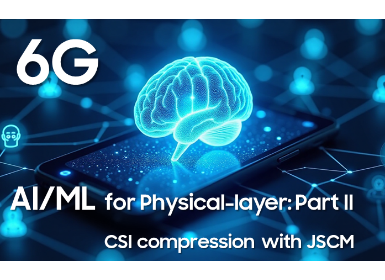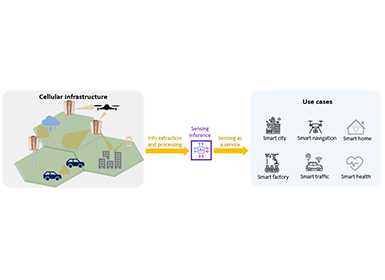Communications
A Beam Scheduling Scheme Based on Real-Time Traffic Distribution in 5G Millimeter-Wave Networks
Background
In 5G Millimeter-Wave (mmWave) networks, Base Station(BS) uses lots of narrow beams for coverage. Due to the limited ability of hardware, BS is only able to select a few beams for scheduling per slot. In outfield scenarios, the moving User Equipments (UEs) and different kinds of traffic lead to dynamic and uneven traffic distribution in beams. Traditional beam scheduling scheme selects beam with the UE scheduling priority and lacks consideration of the traffic distribution. Therefore, a smart beam scheduling scheme is required in mmWave networks to address the dynamicity and imbalance of network traffic. In this paper, a Real-Time Traffic Distribution (RTTD) scheme is proposed for beam scheduling in 5G mmWave networks. RTTD scheme takes the real-time UE and traffic distribution into account, selects the beams with the highest sum efficiency to maximize the throughput. In addition, to improve the fairness of scheduling for each UE, the proposed scheme considers the average throughput of all schedulable UEs.
System Model
In this paper, the BS uses large antenna arrays and hybrid beamforming to form directional narrow beams. The BS is equipped with 2 Radio Frequency (RF) chains, each RF chain controls 1 analog beamformer. Each analog beamformer connects to 1 large antenna array (16H*16V, totally 256 antenna elements). Based on the designed beam book, each analog beamformer can generate tens of narrow beams with different directions, but only 1 beam can be transmitted at each slot. Therefore, the BS supports 2 beams per slot, and UEs in the 2 beams can be scheduled in this slot. For QoS scheduling module, BS needs to select beams firstly, then selects UEs in the selected beams to allocate RBs. Consequently, beam scheduling scheme, which selects optimal beams from a lot of beams, has a great influence on the QoS performance of system.
Proposed Method
A beam without UE does not contribute to the system throughout, and a UE with smaller traffic size may make less contribution to the system throughput. RTTD scheme considers the real-time UE and traffic distribution in beam priority evaluation, calculates the sum traffic size of a beam and predicts which UEs can be scheduled in this beam, and evaluates the beam priority with the effect of all schedulable UEs. Therefore, compared with the traditional scheme, RTTD scheme tends to schedule beam with larger number of UEs and sum traffic size.
Experimental Results
To illustrate the effectiveness of the proposed RTTD scheme, system level simulation is conducted. The QoS performance in terms of system throughput and UE fairness is evaluated. For comparison, QoS performance of traditional scheme is used as a baseline.
In order to reflect the randomness of UE distribution and avoid the small number of UEs in each beam, more than 100 UEs are located in the cell, and different numbers of UE cases are tested to reflect different network loads. Assume that UEs have FTP upload traffic and the packet size is 250 bytes. The detailed simulation parameters are listed in TABLE I.

Table 1. Simulation parameters
Fig.1 shows the system throughput of different numbers of UEs with RTTD scheme and traditional scheme. It is shown that, the proposed RTTD scheme can achieve higher system throughput than traditional scheme. With 200 UEs, 400 UEs, 600 UEs, 800 UEs, 1000 UEs, and 1200 UEs, the system throughput gains of RTTD scheme against traditional scheme are 7.8% , 13.8%, 18.5%, 22.5%,21.2% and 18.8%, respectively. Specifically, with 1000 UEs, system throughput of traditional scheme is 40.1 Mbps, while system throughput of RTTD scheme is 48.6 Mbps.

Figure 1. System throughput comparison
In Fig.2, the Fairness Index of the throughput of all UEs under the RTTD scheme and traditional scheme are calculated and compared. It is shown that the Fairness Index of the RTTD scheme is higher than traditional scheme and the overall trend of Fairness Index is declining as the UEs increase.

Figure 2. UE fairness performance comparison
Conclusion
A smart beam scheduling scheme, named as RTTD scheme, is proposed in 5G mmWave networks to maximize the system throughput and ensure the UE fairness. On the one hand, first, the total efficiency of all schedulable UEs and real-time UE and traffic distribution are considered from system perspective rather than UE perspective. Then, beams with the up-to-date highest efficiency are selected. Both of them contribute to maximize the system throughput. One the other hand, RTTD scheme also considers the average throughput of all schedulable UEs to improve the UE fairness. In addition, this scheme is able to adapt to uneven and dynamic beam loads. System level simulation results show that RTTD scheme gets about 8% to 22% throughput gain and better UE fairness than the traditional scheme. In the future, evaluation methods of beam priority of time-sensitive services, like Ultra-Reliable Low-Latency (URLLC) and Voice over New Radio (VONR), will be studied.
Link to the paper
https://ieeexplore.ieee.org/document/10013058References
[1] A Ghosh, T.A. Thomas, M.C. Cudak, R. Ratasuk, P. Moorut, F.W. Vook, T.S.Rappaport, G.R. MacCartney, S. Sun, and S. Nie, ''Mm-wave Enhanced Local Area Systems: A High-Data-Rate Approach for Future Wireless Networks, '' in IEEE Journal on Selected Areas in Communications, vol.32, no.6, pp.1152-1163, Jun 2014.
[2] S. Rangan, T. S. Rappaport, and E. Erkip, ''Millimeter-Wave cellular wireless networks: Potentials and challenges'', in Proceedings of the IEEE, 2014, pp. 366-385.
[3] W. Roh, J.-Y. Seol, J. Park, B. Lee, J. Lee, Y. Kim, J. Cho, K. Cheun, and F. Aryanfar, ''Millimeter-wave beamforming as an enabling technology for 5G cellular communications: Theoretical feasibility and prototype results'', in IEEE Commun. Mag., vol. 52, no. 2, pp. 106-113, Feb. 2014.
[4] X. Wang, C. Chen and W. Jiang, ''Implementation of real-time LCMV adaptive digital beamforming technology,” 2018 International Conference on Electronics Technology (ICET), 2018, pp. 134-137.
[5] M. Giordani, M. Polese, A. Roy, D. Castor, and M. Zorzi, ''A tutorial on beam management for 3GPP NR at mmwave frequencies'',in IEEE Commun. Surveys Tuts., vol. 21, no. 1, pp. 173-196, Sep. 2018.
[6] S. Han, IC. Lin, Z. Xu, and C. Rowell, ''Large-scale antenna systems with hybrid precoding analog and digital beamforming for millimeter wave 5G'', in IEEE Commun. Mag., vol. 53, no. 1, pp. 186-194, Jan. 2015.
[7] S. S. Kalamkar, F. M. Abinader Jr., F. Baccelli, A. S. Marcano Fani, and L. G. Uzeda Garcia, ''Stochastic geometrybased modeling and analysis of beam management in 5G'', IEEE Global Communications Conference (GLOBECOM), 2020, pp. 1-6.
[8] Y. Liu, X. Wang, G. Boudreau, A. B. Sediq, and H. Abou-zeid, “Deep Learning Based Hotspot Prediction and Beam Management for Adaptive Virtual Small Cell in 5G Networks,” IEEE Transactions on Emerging Topics in Computational Intelligence, vol. 4, pp. 83–94, January 2020.
[9] M. Elsayed and M. Erol-Kantarci, ''Radio Resource and Beam Management in 5G mmWave Using Clustering and Deep Reinforcement Learning'', IEEE Global Communications Conference (GLOBECOM), 2020, pp.1-6.
[10] B. Soleimani and M. Sabbaghian, ''Cluster-Based Resource Allocation and User Association in mmWave Femtocell Networks'', in IEEE Transactionson Communications, vol. 68, no.3, pp. 1746-1759, Nov. 2020.
[11] H. Miao, M. Faerber, M. Fresia and V. Frascolla, ''Joint Beam-Frequency Multiuser Scheduling for Millimeter-wave Downlink Multiplexing'', 2016 IEEE 83rd Vehicular Technology Conference (VTC Spring), 2016, pp. 1-5.
[12] W. Zhang, Y. Wei, S. Wu, W. Meng, and W. Xiang, “Joint Beam and Resource Allocation in 5G mmWave Small Cell Systems,” IEEETransactions on Vehicular Technology, pp. 1–1, July 2019.
[13] J. Cui, Z. Ding, P. Fan, and N. Al-Dhahir, ''Unsupervised Machine Learning-Based User Clustering in Millimeter-Wave-NOMA Systems'', in IEEE Transactions on Wireless Communications, vol. 17, no.11, pp. 7425-7440, Nov. 2018.
[14] Y. Dong, Z. Pan, K. Kang, and J. Liu, ''Fairness-aware hybrid resource allocation with cross-carrier scheduling for LTE-U system'', in Mobile and Wireless Technologies, 2017, pp.114-128.
[15] M.Yoshida, K. Sakaguchi, and K. Araki. "Study on user scheduling with fairness and correlation among the users." IEICE technical report , vol. 108, no.249, pp:31-35, Oct. 2008.
[16] WH. Tarn, J. Chen , and CL. Lee, "Fairness consideration of scheduling for real-time services in 4g systems", in Mathematical Problems in Engineering, 2015, pp.1-9.






